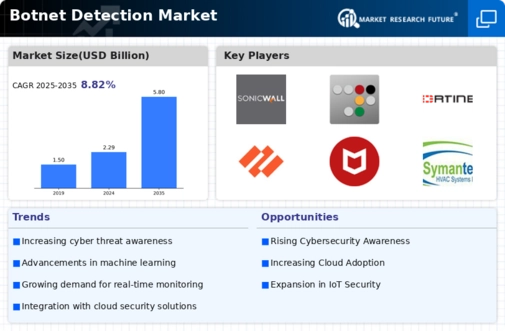Top Industry Leaders in the Botnet Detection Market

Botnet Detection Market: A Cat-and-Mouse Game in the Cyber Jungle
The rise of interconnected devices and online vulnerabilities has fueled the proliferation of botnets Detection – armies of compromised machines controlled by cybercriminals for nefarious purposes. This has sparked a thriving market for botnet detection solutions, with established players and nimble startups vying for dominance in this critical cybersecurity segment. Navigating this dynamic landscape requires understanding the key players, their strategies, and the factors shaping the competitive terrain.
Key Players:
- Akamai Technologies (US)
- Shield Square (India)
- PerimeterX, Inc. (US)
- Distil Inc. (US)
- Imperva (US)
- Intechnica Ltd (UK)
- Instart Logic Inc.(US)
- White Ops, Inc (US)
- Kasada Pty Ltd (Australia)
- Unbotify (Israel)
- Shape Security (US)
- InfiSecure Technologies Inc. (India)
- AppsFlyer (US)
- Variti International GmbH (Switzerland)
- Datadome (France)
- Mfilterit (India)
Strategies for Success:
-
Multi-Layered Defense: Employing a combination of signature-based detection, anomaly detection, and machine learning approaches provides enhanced protection against ever-evolving botnet variants.
-
Threat Intelligence Integration: Integrating with threat intelligence feeds and collaborating with security communities fuels faster identification and mitigation of new botnet threats.
-
Cloud-Enabled Scalability: Offering cloud-based solutions with real-time data analysis and centralized management caters to the needs of geographically dispersed networks.
-
Continuous Innovation and Automation: Continuously investing in research and development to stay ahead of evolving botnet techniques and automating detection and response processes are crucial for staying ahead of the curve.
Factors for Market Share Analysis:
-
Solution Breadth and Depth: Offering a comprehensive range of detection capabilities, including network traffic analysis, endpoint security, and behavioral monitoring, attracts diverse customer segments.
-
Threat Detection Accuracy and False Positives: High accuracy in identifying actual botnets while minimizing false positives minimizes operational disruptions and builds user trust.
-
User-Friendliness and Ease of Deployment: User-friendly interfaces and seamless integration with existing security infrastructure simplify adoption and utilization.
-
Pricing and Deployment Models: Competitive pricing strategies and offering flexible deployment options like on-premise, cloud-based, or subscription models cater to diverse budget needs and preferences.
New and Emerging Companies:
-
AI-Powered Detection: Startups like Cybereason and Darktrace leverage advanced AI and machine learning algorithms to detect anomalies and predict botnet attacks with greater accuracy.
-
IoT Security Specialists: Companies like Nozomi Networks and Palo Alto Networks (Prisma Cloud) address the growing need for specialized botnet detection solutions for industrial control systems and Internet of Things (IoT) devices.
-
Blockchain-Based Security: Startups like Neutrino and Block Armor explore blockchain technology for secure data sharing and tamper-proof evidence collection, potentially enhancing botnet detection and attribution.
Current Company Investment Trends:
-
Machine Learning and Deep Learning: Investments in advanced machine learning and deep learning algorithms for threat detection and behavioral analysis are crucial for staying ahead of sophisticated botnet attacks.
-
Cloud-Native Development: Increased focus on cloud-native solutions with elastic scalability and real-time analytics caters to the evolving needs of modern and hybrid IT environments.
-
Integration with SOAR Platforms: Investments in integrating botnet detection tools with Security Orchestration, Automation, and Response (SOAR) platforms enable automated incident response and faster mitigation of threats.
-
Focus on User Privacy and Data Security: Ensuring robust data security measures and respecting user privacy regulations are becoming increasingly important for building trust and avoiding legal challenges.
The Evolving Threat Landscape:
The botnet detection market is expected to experience sustained growth driven by the expanding attack surface, increasing sophistication of botnets, and the adoption of cloud and IoT technologies. Understanding the competitive landscape, key players' strategies, and emerging trends will be crucial for cybersecurity professionals, businesses, and investors to navigate this dynamic market and effectively combat the ever-evolving threat of botnets.
Latest Company Updates:
-
AI and machine learning: AI-powered solutions are being used to analyze network traffic and identify patterns indicative of botnet activity. -
Behavioral analysis: By monitoring the behavior of devices and applications, botnet detection systems can identify anomalies that may indicate botnet membership. -
Threat intelligence: Sharing and analyzing threat intelligence from various sources helps security researchers stay ahead of evolving botnet trends and tactics.

